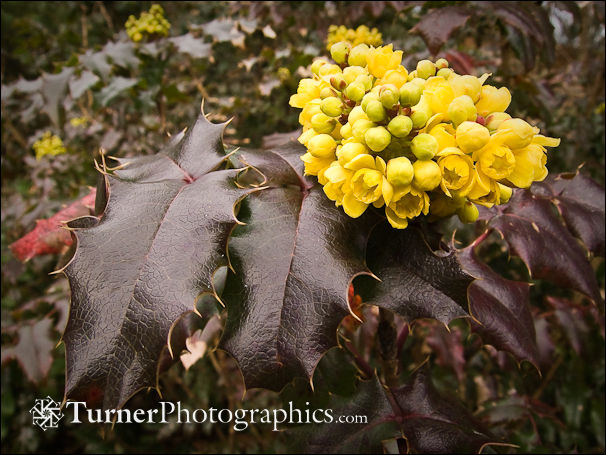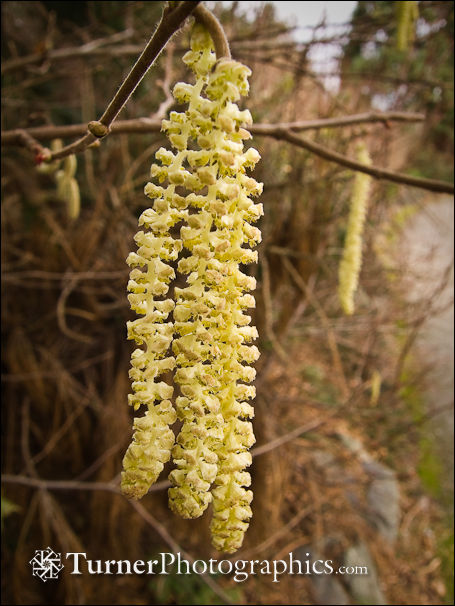Yellow

It’s January 19 and spring is starting to pop. We’ve had several warm days recently, with high temperatures around 50 and some mixed sun and rain. On my walk to the post office this afternoon to mail a couple of fine art prints to customers I perambulated along the Whatcom Creek trail and spied these bright yellow blossoms.
Shining Oregon-grape, Mahonia aquifolium, is one of our two native members of the genus here in Bellingham. It’s the earliest to bloom, although not as early as some of the garden Mahonias with even bigger and more spectacular flower clusters. The leaves sometimes take a beating when we have really cold days, but they’ll be replaced with fresh foliage when spring really arrives later on.
 Hazelnuts, aka Common Filberts, also bloom very early in the spring. Well, maybe it is still officially winter. This is the non-native Corylus avellana. It is cultivated commercially around here, but has also naturalized into the wild all over the place.
Hazelnuts, aka Common Filberts, also bloom very early in the spring. Well, maybe it is still officially winter. This is the non-native Corylus avellana. It is cultivated commercially around here, but has also naturalized into the wild all over the place.
Common Filbert is hard to distinguish from Beaked Filbert, our native species, unless you catch them in fruit. But Common Filbert starts blooming in December and Beaked Filbert doesn’t usually get going until March. For more details on distinguishing them see Botanical Electronic News #389 and scroll down to a comparative table.
Both Filberts bear separate male and female flowers on the same plant. What you’re seeing here are the male flowers, full of pollen. The female flowers are tiny and look like little red bristles. You might not even see them unless you’re looking for them.
I made both of these photographs with my Canon S70 pocket camera, shooting RAW. It can be a little tricky to get the autofocus to make the part of the photo you want to be sharp actually in focus. I used the camera’s macro mode, set by the button with the little tulip symbol, and the lens zoomed all the way out. That’s the standard way to do closeups with most pocket cameras. The trick is to “steer” the autofocus point. On the Canon I pressed the SET button and then used the direction buttons around it to move the focus point (the green box) to my main subject. It takes a little practice to get the hang of it.
Because I was working so close, I couldn’t really put my subject in the center, focus, and then reframe because the distance to the lens would change and I’d lose sharpness. I was in aperture priority mode and stopped down to f/6.3 for these if I remember correctly. For the Hazelnut I hold onto the branch and the camera together to keep the distance from changing in the breeze.
Both of these photos have had a little processing in Adobe Lightroom.
Now that stuff is starting to bloom, all you flower nuts need to get out and start shooting. OK, you don’t really need blossoms for creative images as my friend David Perry points out on his blog and Facebook page. Or maybe you’re just drooling over little green blades of crocus like Mary Ann Newcomer over in Boise. Just find some inspiration and go to it.
Oh yeah, that fancy word in the first paragraph was the word of the day for January 19 at thesaurus.com. Perambulate sounds so much nicer than plain old walking.


Thanks for the filbert key link, Mark!
Mark: You do such excellent photographic work!! I love it! Thank you for sharing it with us! Yes, spring has sprung! Have a great 2010.
Hi Mark, If you look closely you’ll see a blurred female flower in your pix of Corylus catkins.
Good eyes, Wilbur. For the rest of you, the female flower is on the left side of the frame toward the top — the fuzzy red spot.
Drooling? Yes, and fondling, admiring, talking to, coaxing, lauding…any minute now the folks in the van w/the funny white jackets will show up. Heck, I was on my hands in knees with a makeup brush checking for signs of life in the corner of one newly planted tulip bed. Call me crazy.
Your Images are amazing! I enjoy studying that bright yellow in the first images.
WOW!